 print preview
print previewback KEVIN CONCANNON
Actionable Art: From Sam’s Café to United Art Contractors
Conceptual Art on Trial
From 1984 through 1990, self-proclaimed “minor conceptual artists,” United Art Contractors, produced a series of works in the form of direct mail pieces and advertisements in Artforum magazine.1 The pieces were humorous critiques of an art world then flush with hype and cash. In January 1984, their first Artforum adwork, Amuse Us, announced “United Art Contractors, two middle aged artists who don’t have the time or energy to make their own art, have decided to become art patrons to young dynamic up and coming artists with fresh ideas.” Their ad described a competition for the “best art proposal,” which could involve elements such as “sound, fish, or human excrement but please no marble, paint, or canvas.” First prize was five hundrefd dollars; second prize was a black-and-white TV; third and fourth place winners were promised toasters.2
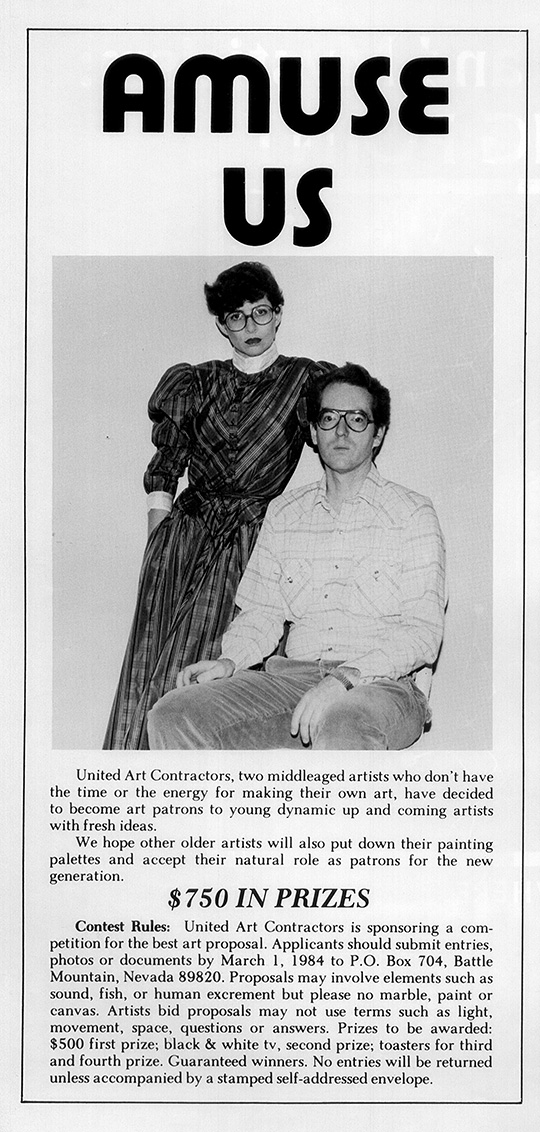 |
| United Art Contractors, Amuse Us, 1984. Advertisement placed in Artforum 22, no. 5 (January 1984): 92 |
Soon ads for “United Art Contractors Legal Division” began to appear.
Use my brain; use my law degree. Minor conceptual artist law student will graduate in May 1985 and be ready to make art in the courtroom. . . . Law is a much better artistic media than paint, clay or even steel beams. Use my brain and my law degree for your own benefit. If you’re interested in merely making money, get lost.3
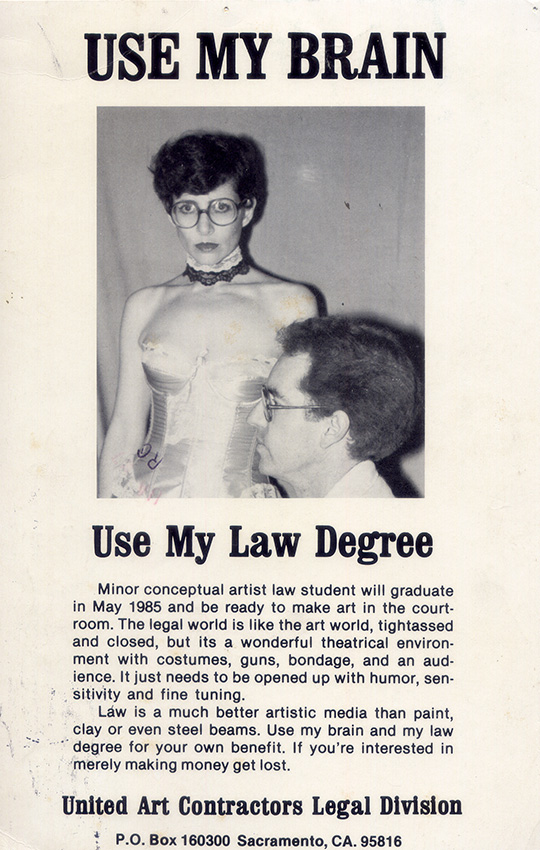 |
| United Art Contractors Legal Division. Use My Brain Use My Law Degree, 1985. Postcard. |
The “Legal Division’s” ads also included Famine Artists in Trouble, which recommended soliciting donations for starving Ethiopians through the mail, using the money to buy electric ice cream scoops and mailing them to Ethiopia. If you’re arrested for mail fraud, “Art is your defense. Art is sharing and caring through international cultural exchange.”4
Members of United Art Contractors, it turns out, had indeed been charged with mail fraud—and had used excrement in their work to startling effect—thirteen years earlier. In March 1971, “Sam’s Café” (a trio of Berkeley-based conceptual artists—two of whom would later re-emerge as United Art Contractors) mailed bills to twenty thousand randomly selected San Francisco residents demanding payment to “Sam’s Collection Agency” of $76.40. No explanation was offered, but a statement warned: “If bill is not promptly paid, action will be taken.”5
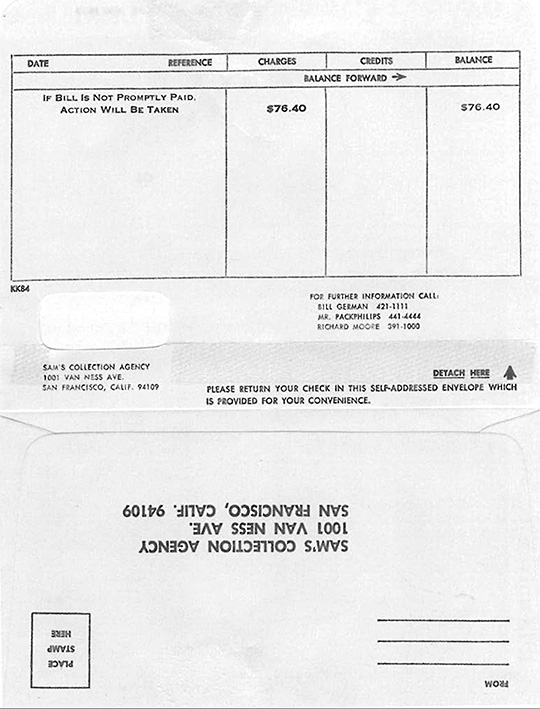 |
| Sam’s Café. Judgment Day: A Media Inversion (detail: bill mailed to 20,000 San Francisco residents), 1971. |
Elsewhere on the bill—which had been professionally printed by Moore Business Forms and served as its own return envelope for payment—were three telephone numbers offered for “further information.” The telephone numbers were in fact not Sam’s, but those of the executive news editor of the San Francisco Chronicle, the manager of KRON-TV—and on some copies—the Bank of America.
Sam’s Café simultaneously issued a press kit—explaining the twenty thousand bills—that included a gold metallic placard with photos of the artists silk screened above three tightly sealed bottles of what was later revealed to be human feces and the texts, “Religious Excrement,” “touch our sacred stools,” “Sam’s Café cashes in on Christ,” and “An art movement like a bowel movement.”
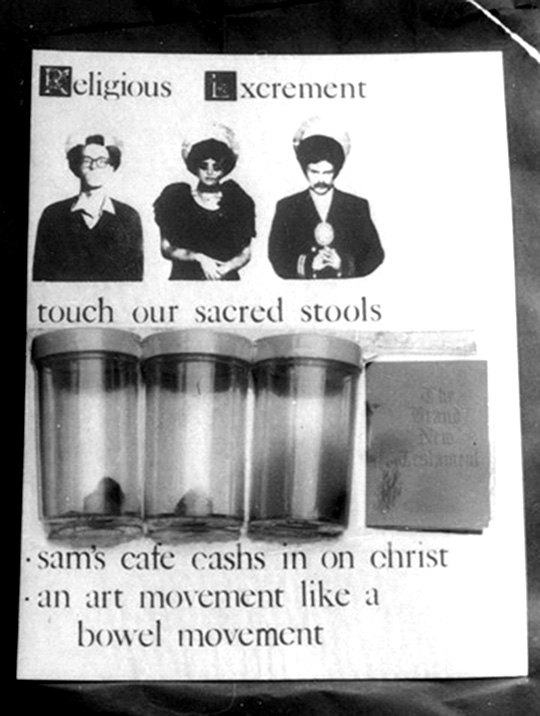 |
| Sam’s Café. Judgment Day: A Media Inversion (detail: press kit placard mailed to news media), 1971. |
 |
| Sam’s Café. Judgment Day: A Media Inversion (detail: press kit placard mailed to news media), 1971. This example is missing the three attached vials containing the “sacred stools.” |
It was all just part of Sam’s Café’s major work, Judgment Day: A Media Inversion. Seven months later, Sam’s Café’s provocative work—a conceptual art project—would emerge from a U.S. District Court in San Francisco in the form of a written decision—the culminating moment in a work of art that can, perhaps, be best understood in the context of Joseph Beuys’ “social sculpture,” or Hans Haacke’s “Real-Time Social Systems.”
The accompanying press release announced: “Our canvas is the mass media. The performance of our work is the indelible mark left on people’s minds.”6 And as the Chronicle itself opined, “This was probably something of an understatement as upwards of 10,000 angry bill recipients jammed police and mass media switchboards . . . with their telephone protests.”7
As explained in the Brand New Testament, a pamphlet resembling a religious tract attached to the press kit placard, “The silent masses are going to speak up in the mass media and become God’s Collection Agency. . . . We will all live in chaos until the Bill is paid and the wicked are burning in hell.”8
On Wednesday evening, the day the bills and press releases arrived at their respective destinations, the San Francisco Examiner’s front-page banner headline blasted: “‘You Owe $76.40’—Hoax Sweeps City.”9
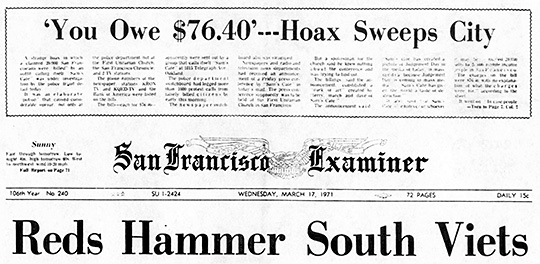 |
| Sam’s Café. Judgment Day: A Media Inversion (detail: headline of San Francisco Chronicle, 18 March 1971: “You Owe $76.40—Hoax Sweeps City”), 1971. |
For three days, police looked for the perpetrators—who had until only a few months before run an alternative gallery in Berkeley in a former lunchroom—the name of which they adopted for their gallery and themselves. After seeing the newspaper headlines and television news reports, the trio went into hiding as they considered how to play out the rest of their “media art” work, as Terri Keyser, one of the group’s members would describe it a few days later.10 By Friday, the stakes were clear; the Examiner’s headline reported “$76 Bill Hoaxers Face U.S. Arrest.”11 That afternoon, the trio held a press conference, fully expecting their arrest to be its culminating moment.
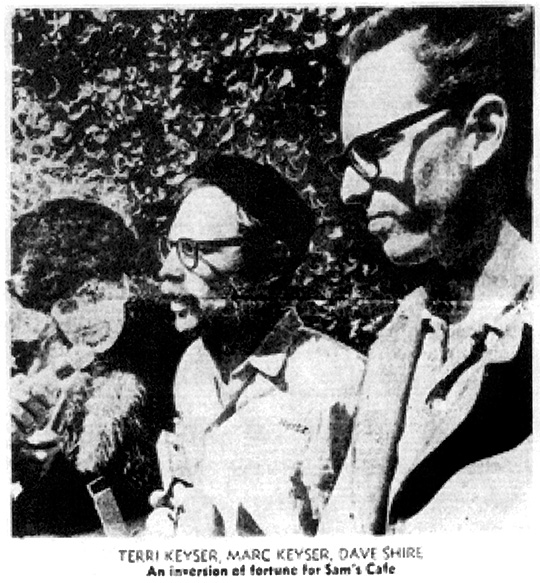 |
| Sam’s Café. Judgment Day: A Media Inversion (detail: news photo of press conference, 19 March 1971, from the front page of the San Francisco Chronicle, 20 March 1971), 1971. |
Thomas Albright, the Chronicle’s art critic—and a key witness in the subsequent trial—described the event in a feature article in Rolling Stone as:
bizarre, Felliniesque . . . Sam’s brought along some friends with videotape equipment, and they took pictures of the press and police cameramen taking pictures of Sam’s. Then they screened the tapes over a TV receiver, and the press and police took pictures of the pictures, like a boggling hall of mirrors.12
For two days the newspapers had been reporting on officials’ plans for Sam’s prosecution. The Examiner reported on Thursday:
. . . first the police must find the people. And then they must figure out exactly what to charge the suspects with. Police chief Alfred Nelder said disturbing the peace might be good for openers. Or felony conspiracy. Chief of Postal Inspectors Earl J. Ingebright said he was delving into mail fraud statutes, extortion laws, and defamation cases, seeking an appropriate charge.13
United States Attorney James Browning Jr. announced on Friday that federal complaints would charge “the mailing of a vile and filthy substance, specifically animal excretion. . . . [The] Decision on whether to ask a federal grand jury for an indictment on fraud charges [was] ‘reserved,’ he added.”14 The Examiner reported that police had not acted earlier because, as Police Chief Nelder explained it, “The District Attorney doesn’t see it our way. There have been preliminary discussions between us. He felt that the facts didn’t disclose any criminal act.” The chief made it clear that he did not agree and that police themselves were combing criminal statutes for “something on which police could act.”15 Shortly after the Friday press conference, the trio was indeed arrested. As the Examiner reported on Saturday, “The three are charged with violating one of the least known sections of federal anti-obscenity statutes. The section forbids the use of the mails for transmission of ‘vile or filthy substances.’”16
On the 14th of April, the Grand Jury handed down the indictment—which included fraud charges as well. The Chronicle reported:
Three conceptual artist[s], who, as Sam’s Café, perpetrated a hoax last month that sent thousands of San Franciscans into an uproar, met cold, unyielding realism yesterday. Terri Keyser, her husband Marc and Davi[d] Shire were indicted by the Federal Grand Jury on four counts of mail fraud, using fictitious names or addresses, mailing obscene matter, and conspiracy. If found guilty they could be fined $17,000 each and imprisoned for a maximum of 25 years.17
In June, Artforum weighed in on the piece as well. In his San Francisco review column, Jerome Tarshis presented the story as it had played out thus far, and offered “a bit of investigation—first published here!—by the news director of a radio station.”18 His informant, who worked for what he described as an underground FM rock station, conjectured that the “sacred stools” might just have been prunes, and sent a sample to a lab for analysis, discovering that they were indeed what they were claimed to be. But it was the fraud charge that most disturbed Tarshis. At first, he explained, “I took this to be a lark. . . . After all, only a fool could be greatly distressed by a bill for $76.40 he should be aware he didn’t owe.” But when a friend pointed out that elderly recipients prone to memory lapses could be greatly distressed, his opinion changed. He concluded his review: “[N]ot clever, not good art, not revolutionary in a productive way. I don’t think jail is good for anybody, so I won’t sign a petition to have these artists put in, but I won’t sign a petition to get them out either. . . . I do not want to live in a New Society that is the work—by default—of nasty, arrogant, children.”19
By the time of the trial in October, the fraud charges had been dropped because there had never in fact been an opportunity for the defendants (the artists) to receive the money. The address given for “Sam’s Collection Agency” was the TV station’s—and the station actually received checks.
As the trial transcript shows, the Government had a straightforward prosecution strategy. The defendants were charged with mailing a vile and filthy substance (the ‘sacred stools’) to the Chronicle, KRON-TV, and the Bank of America. They would first prove that it had been mailed and received by calling witnesses from these three institutions who had received press kits. Cancelled stamps would prove the mails had been used. Fingerprint evidence would tie Terri Keyser to the packages, and a microbiologist would testify that the substance in the vials attached to the press kit was indeed a vile and filthy substance—human feces.
Everything seemed to be going as planned for the prosecutor, as their first witness, Thomas Albright, the Chronicle’s art critic, testified that he did indeed receive the package. But in an apparent attempt to discredit the artistic credentials of the defendants, the prosecutor introduced into evidence a review Albright had written almost two years earlier of a 1969 exhibition at Sam’s gallery. It began:
Sometimes we critics stumble into a really rotten show, but a new gallery called Sam’s Café in Berkeley has a display that is literally putrid, rotten to the core. The show comprises cheeses, sausages, steak, fruits, and other more or less perishable foodstuffs in various stages of decomposition. They are arranged in fancy frames, and sealed within vacuum formed plastic, presumably to prolong the process of decay, and to keep the expression on a purely visual level.
. . . To be sure, the various molds, fungi and other forms of organic growth sometimes produce rich, abstract-expressionist effects of color and surface, particularly in some of the cheeses, a “Big Wiener” and two huge Pollock-sized machines, one painted with rotting Franco-American spaghetti, the other with a mixture of fruit cocktail and cottage cheese. . . .20
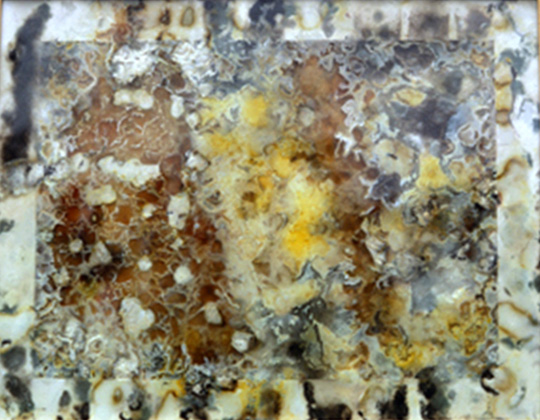 |
| Sam’s Café. Cottage Cheese and Fruit: The Dieter’s Delight, 1969. Dimensions unknown. From the Rotting Food Show, December 7, 1969–January 15, 1970. |
And he concluded: “You can, incidentally, buy little kits of canned food and plastic sealer at Sam’s . . . and create a do-it-yourself rotten show.”21
The prosecutor apparently assumed the review was negative. When he introduced it into evidence, he cited the article’s title as “Art for Decay’s Sake: Oh, Dem Rotten.” But Albright pointed out that the clipping was missing the end of the headline, which read in full: “Art for Decay’s Sake: Oh, Dem Rotten Apples.” He also noted that he didn’t write headlines. When finally asked if the review was favorable or unfavorable, Albright told the prosecutor “It was just kind of amused actually.”22
Sam’s trajectory from alternative space to real-world interventions seems to have begun with the Rotting Food Kits.
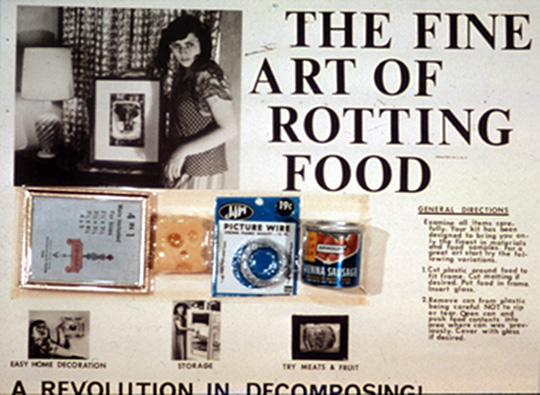 |
| Sam’s Café. Rotting Food Kit, 1969. |
As Terri Keyser-Cooper explained, Sam’s was able to place these rotting food kits, which Albright had referred to in his review, in a local grocery store, which took a small display with great trepidation. And a Berkeley art store, about a half-mile from the University, took Sam’s Pubic Hair Art Kits on consignment as well.23 As Terri’s husband Marc explained to the University of California student newspaper, “Marcel Duchamp picked out a shovel from a hardware store and displayed it as art in a gallery. We’re reversing that process—putting the shovel back in the hardware store.”24 As Terri recalls, it was these projects that won her a place in UC Berkeley’s MFA program, where she was still enrolled at the time of the arrest.25 While none of the many news accounts of the Judgment Day incident consulted for this article made mention of it, Sam’s had already had an interaction with the Berkeley police. According to the Daily Californian (the UC Berkeley student newspaper), a police officer had visited the trio’s Dirty Art Show in February of 1970, informing the trio that if some of the objects in the show were not removed, they would be liable for prosecution.26
In fact, Sam’s had invited the police to pre-emptively censor the open-call, non-juried exhibition, a move that, as Marc would explain in a letter to the editor of the Berkeley Barb, they made to show “Police censorship, like dog shit on the sidewalks, is everywhere. The whole power structure, not merely the police, is trying desperately to censor a new, emerging culture. The Brown-Bag-cover-up is one way of putting it out front and changing the movie around on the police. And that’s always a pleasure.”27
The letter responded to the Barb’s hostile (and clearly misogynist) review of the Dirty Art Show, in which Sam’s was taken to task for censorship, covering the works deemed actionable by the police officer with paper bags (with full explanation of the invited censorship) and providing a soundtrack for the exhibition with the officer’s comments! The review described several of the works on view, concluding: “And, last but not least, BARB’s two favorites, an old time Coke ad with a superwholesome [sic] blonde eating a cock instead of a hotdog, and a Raggedy-Anne type rag doll with tits and pubic hair.” The review concluded with quotes from three recent victims of “obscenity busts,” including City Lights Bookstore. “Owner-poet Lawrence Ferlinghetti had just one word ‘cowardly,’” and a final recommendation: “Do stop by—Terri really does have beautiful tits, though they may be covered with brown paper by the time you get there.”28 It is difficult to imagine that the police were not embarrassed by their “complicity” in the Dirty Art Show. And as noted above, the District Attorney didn’t agree that the facts disclosed any criminal act, but the police were combing criminal statutes for something with which to charge Sam’s; revenge may well have been a motivating factor.
The prosecutor’s attempt to discredit Sam’s Café with his witness’s review seems not only to have failed, but backfired. On cross-examination, the defense attorney was unconcerned with the evidence that the packages were in fact mailed. He began, instead, to immediately establish that they were a part of a larger artwork called Judgment Day: A Media Inversion. And he asked Albright: “[W]ould you describe it as a piece of conceptual art?” The prosecutor immediately jumped in: “Object [sic], your honor. It’s irrelevant and beyond the scope of direct.” But the Court denied him: “Oh, I don’t know. You asked him whether the article was favorable or unfavorable, and I think that opens up enough cross-examination.”29 The judge then asked the witness directly if this work—which he referred to as a play—had any relationship to “that which was received in the mail.” Albright responded:
I walked into work in the morning and I picked up these things, and I immediately took this to the city editor, because—I told him if he got a bunch of phone calls, it’s going to be part of this art work. And about an hour or two later, he asked me to do a story about how this could fit into the context of an art work, because they had begun receiving a great number of phone calls in response to the numbers that were listed on these bills. So, I wrote a story [that] appeared in the next morning’s paper explaining that this was a work of conceptual art or process art, that it was using the media.30
Having established that the package had in fact been received, the judge asked Albright if he detected any odor coming from the canisters. And he answered “no.” After Albright revealed that he brought it home to show his wife, the defense attorney seized this opportunity to ask the question: “did you find it vile and filthy?”
“No,” responded Albright.31
The judge, apparently incredulously, asked the witness “did you deem this conceptual art?”
“I did, yes.”32
The defense attorney then asked him for a shorthand definition of conceptual art or process art. Albright responded:
Yes, it’s a form of art that involves a calculated use of the environment, as opposed to traditional materials of canvas and paint or marble or what have you. And the process [that] takes place is the work, rather than a product, [or] a conventional object [that] can be preserved in a museum or displayed in a gallery. The process itself constitutes the art.33
Virtually quoting the trio’s press release, the defense attorney asked: “[W]ould it be a fair analogy to say, then, that in a work of process art or conceptual art, the media in effect serves as the gallery or serves as the canvas for the work?”
The prosecutor again objected, and the judge once again addressed the witness:
“I don’t know. I’m going to ask a question. You are an art critic. You have given us a definition of conceptual art. The question is, do you in your opinion say that product is, which you have before you now, is a form of conceptual art?”
“Yes.”
And the judge responded: “I accept your opinion at the moment. I am rather amazed, but that’s the way it is. . . . Now, when you formulate your opinion on what constitutes conceptual art, you don’t discriminate between the filthy and that which is not filthy, do you?”
“Well, I don’t deem this especially filthy, really.”34
Again, the judge: “And as an art critic, it’s your further opinion that this is not filthy?”
“Yes, really.”
“Is that your opinion?”
“Yes, right.”
“All right.”
The defense attorney then asked Albright: “Sir, are you aware of fecal matter being used in art works in the past?”
The prosecutor: “Objected to as irrelevant. Submit all this testimony is irrelevant.”
And again, the judge interceded: “I will ask him. This is getting even beyond Fellini. Go ahead.”
Albright answered: “I am aware only by second hand, so really, I would be reluctant to discuss it. It’s possibly just a piece I read in the paper about something that happened in Italy.”35
More likely than not, both the defense attorney and Albright were referring to Piero Manzoni’s Artist’s Shit of 1961, an edition of ninety tins of the artist’s stools sold for their weight in gold. With this, cross-examination was concluded.
On redirect examination, the prosecutor tried again to emphasize the “vile and filthy” nature of the “sacred stools,” asking if it would change Albright’s opinion that the vials were not vile to know that they contained bacteria. Albright held firm.
During re-cross-examination, the judge asked Albright: “I assume that the function of art is to appeal to the senses of the viewer. Is that correct in some form?”
“Not necessarily,” he replied.
“What other function could it serve?”
“I think the function of art is to make people see things in ways they haven’t seen them before.”36
Before Albright was finally dismissed, the defense attorney asked him: “Is it your opinion . . . as an art critic, that conceptual art and process art will gain a place in the general public’s recognition?”
And the judge asked: “That has what?”
“Will gain a place.”
Again, the judge: “Will gain a place? I hope not. But I will see what his answer is.”
Albright responded: “Well, to a large degree it has already.”37
As promised, Albright’s testimony was followed by that of employees of the television station and the bank. Subsequently a microbiologist testified that he had tested the “sacred stools,” and they were indeed feces, although it was not possible to distinguish between animal and human.
On cross-examination, the defense attorney established that the microbiologist had children whose diapers he had changed—and had not found vile and filthy. Discussion followed to the effect that one’s perception of the vile and filthy nature of feces changes depending upon the circumstances. He also established that feces were regularly sent through the mails by laboratories such as the one for which the witness worked. The case, however, was ultimately decided based almost entirely on Albright’s testimony.
In his written decision, the judge stated:
Whether the fecal matter was filthy depends on the way it was transmitted and the purpose intended to be served. While the court finds the conduct of the defendants to be reprehensible and in utter disregard of the sensibilities of others, the fact remains that in the instant case the Government’s own witness, Mr. Albright, was utilized by defendants as an expert witness, as an art critic.
He described that which he received through the mails as conceptual art and he did not in his opinion deem the same to be filthy or vile.
While I view the material placed in the mails to be personally offensive and beyond my understanding of that which is art, I cannot ignore the testimony of Mr. Albright and therefore a reasonable doubt arises as to whether the material can be described as a filthy and vile substance within the meaning of the applicable statute.38
He then acquitted the artists.
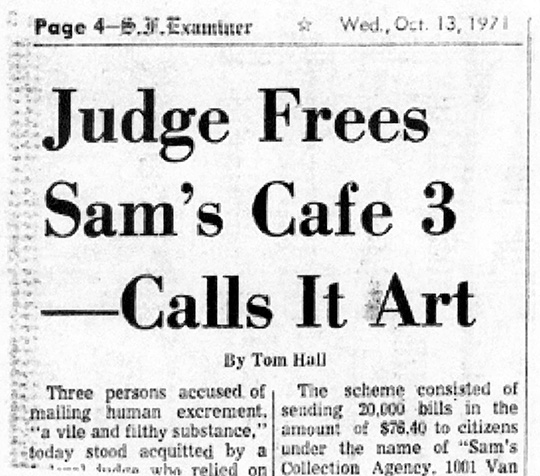 |
| Sam’s Café. Judgment Day: A Media Inversion (detail: headline: “Judge Frees Sam’s Café 3—Calls It Art,” San Francisco Examiner (October 13, 1971): 4. |
Ironically, only a few months earlier, Terri was refused her MFA after submitting the so-called “phony bill caper” as part of her MFA show.39 Strangely, the Federal Government was more generous in its critique than the UC Graduate Faculty—or Artforum—had been.
By 1975, Marc was teaching third grade, and Terri and Dave, still enamored of the media, had launched a successful, small-town newspaper, The Battle Mountain Bugle, in Battle Mountain, Nevada. As Terri explains: “In the next town, which was Winnemucca, they put in a big shopping center, and before you knew it, the big chain stores were advertising in our little paper. Our little paper became a huge success. Later, Terri divorced Marc and, in 1982, sold the newspaper, and began law school. In 1984 Terri and Dave—as United Art Contractors—resumed the work of Sam’s Café. Soon they were “making art with the art world,” as Terri describes it.40 Their vehicle, appropriately enough, was Artforum, whose critic had announced his decision thirteen years earlier not to lift his pen in their defense should they be sentenced (to a maximum of twenty-five years).
We’re Desperate: We Want to Buy Our Way into a Show appeared in the March 1984 issue of Artforum.
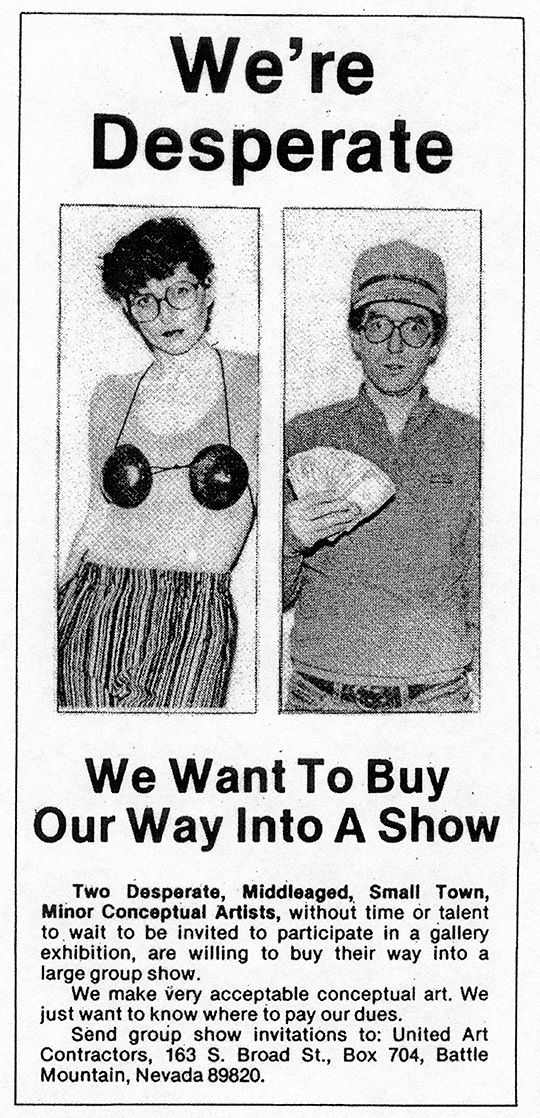 |
| United Art Contractors. We’re Desperate: We Want to Buy Our Way into a Show, Artforum 22, no. 7 (March 1984): 112. [advertisement]. |
The piece describes “two desperate, middle-aged, small-town, minor conceptual artists without time or talent” who want to buy their way into a large group show. In September’s Brilliant New Work by United Art Contractors, they revealed that they paid for reviews: “Rave review by well known art critic $150, medium review by well known art critic $100, bad review by well known art critic $50, dynamite review by average art critic $75, ok review by average art critic $50, poor review by average art critic $25; any kind of review by unknown art critic (it’s all the same anyway) $10.”41
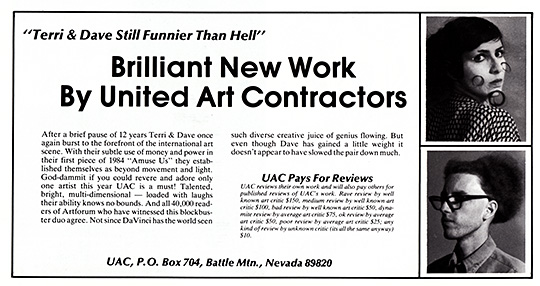 |
| United Art Contractors. Brilliant New Work by United Art Contractors, Artforum 23, no. 1 (September 1984): 16, [advertisement]. |
March of 1985 brought You Get What You Pay For: No Talents Buy Their Way In. Michael Selic, president of Works, San Jose, took the Contractors’ thousand dollars—along with their stipulation that he spend it entirely on himself—not the gallery. The show consisted of “one hour of polite conversation with wine and cheese (but only polite conversation, we don’t want any criticism.)”42
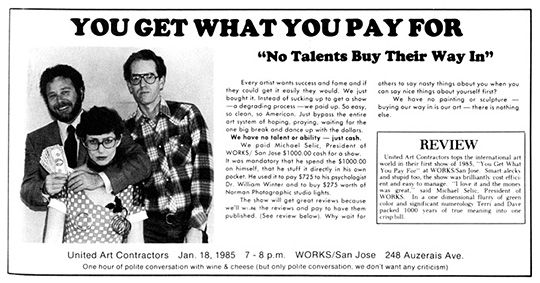 |
| United Art Contractors. You Get What You Pay For: “No Talents Buy Their Way In.” Artforum 23, no. 5 (January 1985): 31 [advertisement]. |
Advertising works by United Art Contractors and its “Legal Division” appeared in Artforum and the San Francisco Bay Guardian as well as direct mail pieces through 1990. The Works project was the Contractors’ last, a fitting finale to a body of work that exploited the media to expose its complicity in a system on which it ostensibly objectively reported. Speaking of Judgment Day, Terri Keyser-Cooper recalled: “We were doing this during all the street demonstrations against the Vietnam War. It was Marc’s idea, and it was a great idea. He felt—and we heartily endorsed—that carrying a sign and protesting in the streets had very little value. What had major value was shutting down major corporations and businesses. And you could shut them down by closing off their use of the phone. And that was a powerful, powerful thing.”43 The Bank of America was a major target. Its branch in Isla Vista, California (adjacent to the UC Santa Barbara campus) had been burned the year before by student protestors, prompting Governor Reagan to declare a state of emergency. Thirteen years later, the target had changed to the art world itself—specifically the relationship of art and money. Once again, the press served as the vehicle, but this time it was bought and paid for. The humor was more light-hearted than strident, but no less stinging. Nonetheless, Keyser-Cooper insists “I’ve always loved the media, and see it as a medium to be used just like any other. It wasn’t negative against the media in any way.”44
United Art Contractors has remained dormant sine 1990. Terri is now a prominent civil rights attorney in Reno, Nevada. But long before she earned her law degree, she helped establish a legal definition of conceptual art in the course of her unsuccessful bid for an MFA at University of California, Berkeley. ![]()